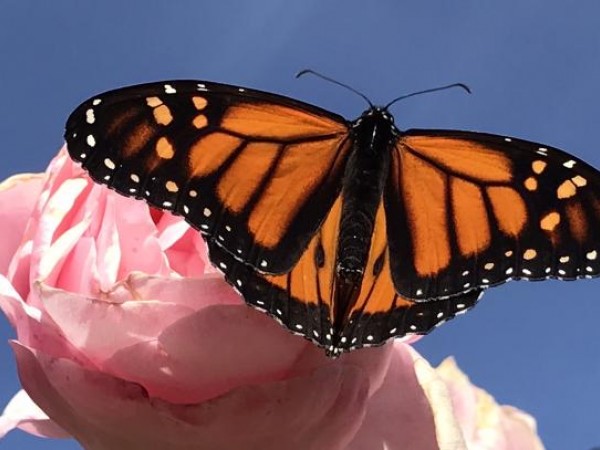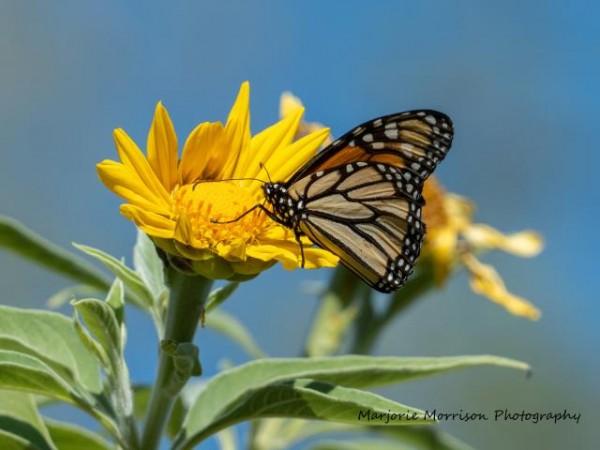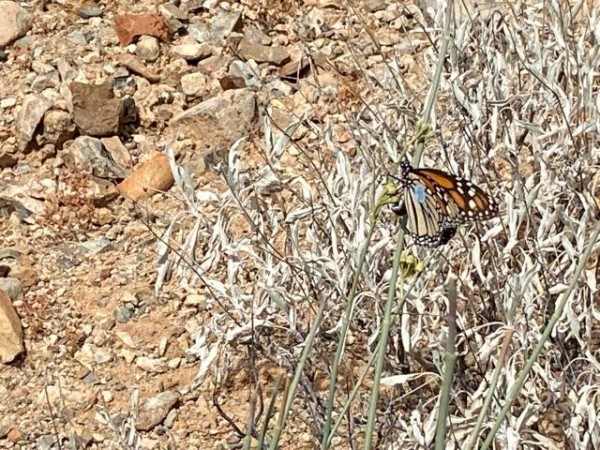Letter from Gail Morris: Western Monarch Winter 2021–22 Report #1
Published: 12/15/2021
Dear Western Monarch Friends,
The news about Western Monarchs this year continues to be amazing, especially after the extremely small number counted just a year ago. The Xerces Society reported over 200,000 monarchs along the California coast, and everyone is eager to hear the final Thanksgiving Count. This week monarchs were reported primarily in California and Arizona, a harbinger of the winter season in the West.
Western Monarch Sightings
Recent sightings contain rich details about their encounters with monarchs. Your observations are valuable! Here are some samples.
It was a very warm Fall season but even so a monarch reported in Prescott Valley at 5,026 feet elevation is unusual in December. But Barbara in Prescott Valley, Arizona, saw a monarch in her yard on November 29 and sent in a photo to document her finding. “Feeding on Jupiter's beard blooms and resting on roses. Noticed it mid-morning in my backyard and it stayed for around 4 hours. A male in perfect condition, very active, and no ID tag.” It is a most unusual year.
Della reported monarchs in Superior, Arizona on December 3. “2 adults seen flying around the Wolfberry (Lycium) that had small lavender blooms. One had very torn wings, the other looked fresher. Difficult to tell the gender. 12pm, 78F, no breeze or clouds.” Ten years ago Superior would have already had their first frost of the season but this was a warm Fall.
Susan in El Segundo, California, reported 5 monarchs on December 6. “5 Monarchs flying around tall pine trees at 10 am in the morning on a sunny day.”
Marjorie found monarchs in Tucson on December 6. “Hello Journey North Friends, We are in Tucson for the winter and saw 3 monarchs at the butterfly garden at Tohono Chul Park. Here is one of them on a tithonia (Mexican sunflower) that blooms almost year-round.” Be sure to see Marjorie’s photo.
On the same day James spotted a monarch in Green Valley. “Male returned at 11:00 am (Mountain Time) 68 degrees then, on its way to 80 degrees w/ no clouds and 5 - 10 mph breeze. It appears to be the same male I have had for the last 2 days. He sipped water from moist soil for approx. 1.5 hours and then on to nectar at my Lantanas. He disappeared for 2 hours and back to Lantana by 3 pm. He roosts in same mesquite tree the last 2 nights (east side). Overnight temps 48 F.” Monarchs favor the South and Southeast side of trees at night to warm up in the morning sun and James was able to document this behavior.
On December 7 James also found monarchs in Tucson. “Saw at least 7 monarchs at the Arizona Sonora Desert Museum (ASDM), Tucson. One tagged female oviposited on A. subulata which was in early bloom at many locations of the outdoor museum. I was not successful at collecting the tagged female but observed her laying at least 7 eggs (approx. 12:10 pm - sunshine 69 - 71 degrees, w light breeze) at the base of the flowers where they were attached to the main plant stem. Ambient temp reached 79 degrees by 4 pm. Monarch tagging events are apparently a near weekly event at the museum, so the tagged female could be from a recent tagging effort.” (James is right! Several docents are trained to tag and do so when they are volunteering to share information about monarchs in the Southwest.)
Some people are finding monarch eggs in Southern California. On December 8, Jamie in San Diego reported, “Found 6 monarch eggs.” Community Scientists reports helps us document the many phases of the monarch life cycle available during the winter months as we all strive to learn more about their survival methods.
California Monarch Overwintering Counts Rise!
The annual Thanksgiving count of monarchs along the California coastal region was just completed and the Xerces Society is still tabulating the final numbers. The preliminary numbers are exciting, with over 200,000 monarchs estimated in a recent Facebook post by the Xerces Society: https://fb.watch/9Pf8NjaQif/. Monarch numbers are especially good in the larger sites at Pismo Beach and Pacific Grove but to the delight of everyone in the region the Southern California sites are also experiencing an increase.
What looks the same and what appears different this year? Xerces notes there are fewer monarchs in the Bay area compared to last year. Last year there was a large number of breeding monarchs in the Bay area in comparison to earlier years. What are local observers seeing this year? Terry Smith of the Pollinator Posse shares, “What we're seeing in the Bay Area in December is caterpillars and adults winding down. We had a surge of egg laying and caterpillars from September through mid-November. During this time we observed more tattered adults (probably migrants) and the paper wasp predation was much reduced so caterpillars were able to survive beyond the 2nd instar. Now temperatures are dropping - low 50's during the day to low 40's at night - and we're seeing just a few straggler caterpillars, which are very slow growing.”
Arizona Counts Thanksgiving Monarchs, too!
While well-known and new California monarch overwintering sites are the primary focus of the annual Thanksgiving Count, you might be interested to know Arizona winter monarchs are also at a few locations. This year at Rio Salado Habitat Restoration Area in downtown Phoenix we counted 13 monarchs and at Rotary Park in Lake Havasu, Michelle, Rexy and their family joined me to watch and count 106 monarchs flying into Aleppo Pines and Eucalyptus trees to roost from mostly as singletons but there were a few pairs a few inches apart. Both of these locations experienced warm daytime temperatures of 85 degrees for an extended period in November likely contributing to their positioning and were noting good numbers of monarchs in backyard gardens as well.
Winter Monarch Sightings Matter!
In a year of drastically changing monarch numbers, their locations become extremely important! If you are seeing monarchs, be sure to report to Journey North whether they are adults or if you see eggs or larvae as well. Try to provide as much information as you can such as weather conditions (it’s okay to estimate), your description of what you see in detail including but not limited to the monarch’s gender or activity including the type of flowers if they are nectaring if known. If you can, observe the condition of the wings – are they fresh and new or worn and tattered or something in between – helps us learn more about monarch survival. Please take a photo if you can and we do realize this isn’t always possible. Thanks so much for your help.
Gail Morris is the Coordinator of the Southwest Monarch Study (www.swmonarchs.org), a Monarch Watch Conservation Specialist, and the Vice President of the Monarch Butterfly Fund and the Central Arizona Butterfly Association. The Western Monarch Population News is based on comments provided to Gail Morris. We hope to increase the number of sightings and therefore photos and comments entered into the Journey North. We rely on the volunteers who communicate regularly with Gail and who agree to participate in our effort to increase awareness of the population of western Monarchs. You can reach her at gail@swmonarchs





